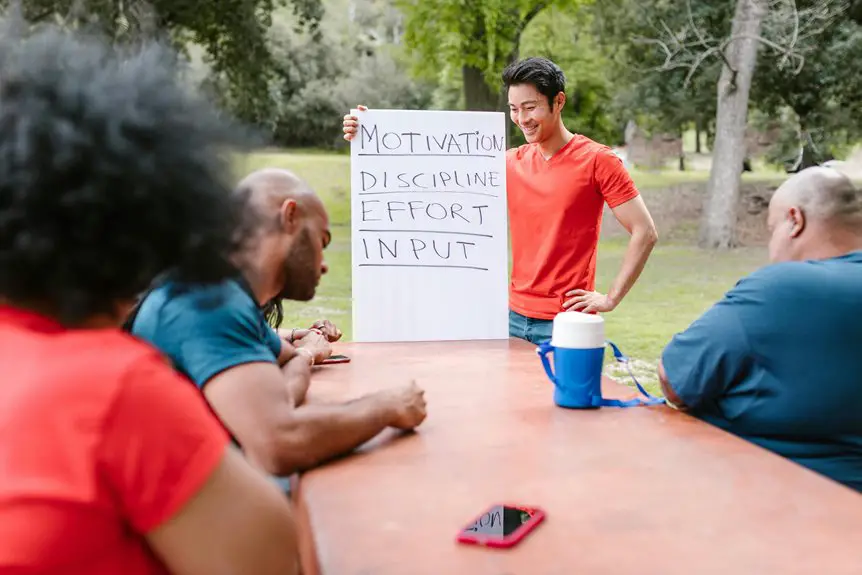Steering through the nuances of team communication can sometimes feel like walking a tightrope. To guarantee everyone feels included and engaged, you’ll need to adopt strategies that cater to diverse backgrounds and time zones. This isn’t just about tools; it’s about creating an environment where every voice matters. So, what are the key steps you can take to enhance accessibility in your team’s communication?
Table of Contents
Key Takeaways
- Assess team needs to choose communication tools that accommodate different tasks and time zones, ensuring accessibility for all members.
- Establish clear communication guidelines, specifying channels for various message types and setting response time expectations to promote accountability.
- Embrace asynchronous communication, allowing team members to engage on their schedules while fostering inclusivity and valuing diverse contributions.
- Utilize video conferencing with high-quality visuals and breakout rooms to enhance engagement and facilitate intimate discussions among smaller groups.
- Regularly solicit feedback on communication practices and analyze participation rates to identify areas for improvement and enhance overall collaboration.
Understanding the Challenges of Distributed Communication
As you navigate the complexities of distributed communication, you’ll quickly realize that various challenges can hinder effective collaboration.
Time zone differences can complicate scheduling, making it tough to find convenient meeting times for everyone. Miscommunication often arises due to lack of non-verbal cues, which can lead to misunderstandings and frustration.
Time zone differences and the absence of non-verbal cues can create significant barriers to effective communication in distributed teams.
Additionally, the reliance on technology means that technical issues can disrupt communication flow, causing delays and confusion. It’s also easy to feel isolated when working remotely, which can impact team morale.
Furthermore, differing cultural backgrounds may influence communication styles, leading to potential conflicts. Recognizing these challenges is the first step in developing strategies that enhance understanding and cooperation within your distributed team.
Choosing the Right Communication Tools
When choosing the right communication tools, you need to assess your team’s specific needs first.
Then, explore various options that align with those needs while ensuring they come with accessibility features.
This way, you can create an inclusive environment where everyone can participate effectively.
Assess Team Needs
To effectively choose the right communication tools for your team, it’s crucial to assess their unique needs.
Start by identifying the specific tasks your team members perform and the types of communication they require—whether it’s instant messaging for quick questions or video calls for detailed discussions.
Consider the varying time zones and availability of team members; flexibility is key.
Evaluate your team’s tech-savviness, as some might prefer simpler platforms while others may be comfortable with advanced tools.
Don’t forget to factor in accessibility concerns; make certain that chosen tools cater to all team members, including those with disabilities.
Explore Tool Options
Choosing the right communication tools requires careful evaluation of your team’s specific needs and preferences.
You should assess various options to find the best fit for your workflow. Here are some key factors to contemplate:
- Ease of Use: Ascertain the tool is user-friendly for everyone on the team.
- Integration: Look for tools that seamlessly connect with the software your team already uses.
- Real-Time Collaboration: Choose tools that facilitate quick, effective communication, like chat or video conferencing.
Ensure Accessibility Features
While evaluating communication tools, it’s crucial to prioritize accessibility features that cater to all team members. Look for platforms that offer screen reader compatibility, keyboard navigation, and captioning for video calls. These features can greatly enhance participation for those with disabilities.
Choose tools that allow customization of text size, colors, and layouts to accommodate various preferences.
Don’t forget to test the tools with your team before fully implementing them; gather feedback to verify everyone feels included. Additionally, consider tools that provide multilingual support if your team is diverse.
Establishing Clear Communication Guidelines
Establishing clear communication guidelines is essential for fostering an inclusive environment where everyone feels valued and understood.
Establishing clear communication guidelines fosters inclusivity, ensuring everyone feels valued and understood within the team.
When you set these guidelines, you create a framework that helps team members engage effectively. Here are a few key points to contemplate:
- Be explicit about communication channels: Specify which tools to use for different types of messages, whether it’s email for formal updates or chat for quick questions.
- Encourage active participation: Make it clear that everyone should contribute during discussions, ensuring diverse perspectives are heard.
- Set response time expectations: Clarify how quickly team members should respond to messages, promoting accountability and reducing uncertainty.
Embracing Asynchronous Communication
As the pace of work continues to evolve, embracing asynchronous communication can greatly enhance your team’s effectiveness.
This approach allows team members to engage on their schedules, accommodating different time zones and personal commitments. By using tools like email, project management software, or recorded messages, you encourage thoughtful responses rather than immediate reactions.
It fosters deeper reflection and more thorough input, leading to better decision-making. Additionally, you can document discussions, making it easier for everyone to refer back to important information.
Remember, asynchronous communication doesn’t mean lack of connection; it encourages a more inclusive environment where everyone feels valued.
Encouraging Regular Check-Ins and Updates
To keep your team aligned and engaged, regular check-ins and updates are essential. These interactions foster a sense of community and guarantee everyone stays on track with their tasks.
Here are a few strategies to implement:
- Set a consistent schedule: Whether it’s daily or weekly, having a regular time for updates helps everyone anticipate and prepare for these discussions.
- Encourage open dialogue: Create an environment where team members feel comfortable sharing their progress, challenges, and ideas. This builds trust and collaboration.
- Use shared tools: Utilize project management tools and communication platforms to streamline updates and keep information accessible.
Leveraging Video Conferencing for Engagement
Video conferencing can greatly boost engagement by enhancing your visual connection with participants.
When you encourage active participation and utilize breakout rooms, everyone feels more involved and invested in the discussion.
Let’s explore how these strategies can transform your virtual meetings.
Enhancing Visual Connection
While many communication methods can be effective, leveraging video conferencing offers a unique opportunity to enhance visual connection and engagement. By seeing your teammates, you create a more personal atmosphere that fosters collaboration.
Here are a few strategies to maximize this visual connection:
- Utilize high-quality video: Guarantee everyone has a clear view of each other to foster better understanding and connection.
- Encourage appropriate backgrounds: A tidy or relevant backdrop can enhance professionalism and focus during meetings.
- Incorporate visual aids: Use slides, charts, or shared screens to keep everyone visually engaged and highlight key points.
Encouraging Active Participation
Active participation can greatly enhance the effectiveness of video conferencing, especially when team members feel encouraged to engage.
To foster this environment, start by setting clear expectations for participation. Ask open-ended questions and invite everyone to share their thoughts. You might even consider implementing a round-robin style discussion, giving each person a chance to speak.
Utilize visual aids and interactive tools like polls or shared documents to keep everyone involved. Make sure to acknowledge contributions, reinforcing that every voice matters.
Additionally, maintain eye contact by looking into the camera, which helps create a connection.
Utilizing Breakout Rooms
Creating an engaging environment during video conferences can be taken to the next level by utilizing breakout rooms.
These smaller, focused spaces allow for more intimate discussions and foster collaboration among team members.
Here’s how you can make the most of breakout rooms:
- Encourage Participation: Assign specific roles to each participant, ensuring everyone has a voice and feels accountable.
- Facilitate Focused Discussions: Give teams a clear agenda or topic to explore, keeping conversations productive and on track.
- Gather Feedback: After sessions, reconvene to share insights and lessons learned, reinforcing community and shared knowledge.
Fostering a Culture of Inclusivity
To foster a culture of inclusivity, you need to prioritize open communication and actively engage all voices within your community. Encourage team members to share their ideas and perspectives by creating a safe environment where everyone feels valued.
Regularly solicit feedback and demonstrate that you’re listening by implementing suggestions when possible. Make an effort to recognize and celebrate diverse viewpoints, ensuring that every team member feels their contributions matter.
Additionally, consider holding team-building activities that promote understanding and collaboration among different backgrounds. By consistently modeling inclusive behavior and encouraging participation, you’ll cultivate a sense of belonging that enhances teamwork and drives innovation.
Ultimately, inclusivity isn’t just a goal; it’s a continuous practice that strengthens your entire team.
Utilizing Collaborative Platforms for Teamwork
Building on a culture of inclusivity, leveraging collaborative platforms can greatly enhance teamwork and communication.
Embracing inclusivity through collaborative platforms can significantly boost teamwork and communication within your organization.
These tools not only streamline processes but also foster a sense of community among distributed teams. To maximize their effectiveness, consider these strategies:
- Choose the right platform: Select tools that suit your team’s needs—whether it’s for file sharing, messaging, or project management.
- Encourage participation: Create spaces for everyone to share ideas, ensuring no voice is left unheard.
- Integrate feedback loops: Regularly solicit input on platform usage to continually improve collaboration and address any challenges.
Being Mindful of Time Zones and Cultural Differences
While collaborating across different time zones and cultures, it’s essential to recognize how these factors can impact communication and teamwork.
Start by being aware of your teammates’ local times when scheduling meetings. This shows respect and consideration, making everyone feel valued. Use tools like world clocks or scheduling apps to streamline this process.
Cultural differences also play a significant role. Understand that communication styles, attitudes toward hierarchy, and even humor can vary widely.
Taking the time to learn about your team’s cultural backgrounds fosters inclusivity and enhances collaboration. Encourage open dialogue about these differences, which can lead to stronger relationships and better teamwork.
Tracking and Measuring Communication Effectiveness
Effective communication isn’t just about exchanging messages; it’s essential to track and measure how well those messages resonate with your team.
By monitoring communication effectiveness, you can identify areas for improvement and enhance collaboration. Here are three key methods to evaluate:
Monitoring communication effectiveness is crucial for identifying improvement areas and fostering better collaboration.
- Surveys and Feedback: Regularly ask team members for their thoughts on communication practices. This helps gauge clarity and effectiveness.
- Engagement Metrics: Analyze participation rates in meetings and discussions. High engagement indicates effective communication.
- Follow-Up Actions: Assess how well team members act on shared information. If they’re implementing suggestions, your messages are likely resonating.
Frequently Asked Questions
How Can I Improve My Listening Skills in Virtual Meetings?
Listening in virtual meetings is like tuning a fine instrument; you need focus. To improve, practice active listening, ask clarifying questions, and minimize distractions. Your engagement will create harmony, making conversations more productive and enjoyable.
What Are Best Practices for Writing Clear Emails to Remote Teams?
To write clear emails to remote teams, keep your language simple, use headings for structure, and be concise. Always proofread for clarity, and include a call to action to guide your team’s response effectively.
How Can I Encourage Shy Team Members to Participate?
To encourage shy team members to participate, create a safe space, foster open dialogue, and celebrate contributions. When you invite them to share, acknowledge their input, and offer support, they’ll feel more comfortable engaging.
What Tools Help With Real-Time Language Translation for Teams?
For real-time language translation, you can use tools like Google Translate, Microsoft Translator, or Zoom’s live translation feature. These tools enhance communication, ensuring everyone understands each other and feels included during discussions.
How Do I Handle Misunderstandings in Distributed Communication?
To handle misunderstandings, clarify your message promptly. Ask open-ended questions to gauge understanding, and encourage team members to share their thoughts. It’s crucial to foster an environment where everyone feels comfortable discussing uncertainties.




